MXA RACE TEST: THE REAL TEST OF THE 2020 KAWASAKI KX450
MXA RACE TEST: THE REAL TEST OF THE 2020 KAWASAKI KX450
Q: FIRST AND FOREMOST, IS THE 2020 KX450 BETTER THAN THE 2019 KX450?
A: It is if you are easily impressed by Bold New Graphics (BNG), because the only difference between a 2019 KX450 and 2020 Kawasaki KX450 is the Comic Book typeface on the 2020’s radiator wing. Offsetting the total lack of improvement is the fact that the KX450 was all new in 2019. Why didn’t they fix the most obvious flaws? That’s simple: Kawasaki’s pencil pushers forked out big bucks to design the 2019 KX450, so the bank was closed this year. The $9299 2020 Kawasaki KX450 may not be better than the 2019 version, but MXA knows a lot more about how to make it tick—and it can tick pretty well.
Q: WHAT WAS NEW ON THE KX450 LAST YEAR?
A: It was a totally new machine in 2019 and benefited from major engine, suspension and chassis modifications 12 months ago. Here is a quick rundown by category.
Engine: The 2019 got a 17-gram lighter bridge-box piston, plain bearings in the connecting rod’s big end, an 8.5mm offset cylinder, semi-dry sump crankcase, 4mm larger intake valves (with 0.8mm more lift), 2mm larger exhaust valves (with 0.5mm more lift), finger-followers, a 10-degree downward intake tract angle, 1mm-larger throttle body (with a butterfly valve that opens from the top), 12-hole injector that sprays 75-micron droplets and flows 20-percent more fuel, 105mm-longer head pipe, hydraulic clutch and electric starting.
Suspension. Last year Showa coil-spring forks replaced the previously unpopular Showa SFF-TAC air forks that were on the on the 2018 KX450F. Additionally, the front axle increased from 20mm to 25mm. The shock’s rising-rate linkage was revised, and the shock was moved 5mm to the right.
Chassis. In 2019, there was a new front-brake master cylinder. The rear-brake rotor was increased from 240mm to 250mm. The footpegs were widened 5mm and moved 3mm further rearward, while the bodywork was narrowed at the radiator shrouds.
Q: HOW DOES THE 2020 KAWASAKI KX450 RUN ON THE TRACK?
A: This is a phenomenally usable powerband that makes you forget that the 2020 KX450 makes less horsepower than every other 2020 450, save for the 2020 RM-Z450. The 2020 KX450 has approximately 4-horsepower less peak horsepower than the 2020 CRF450. Don’t let that worry you, though. The KX450’s power delivery is so brisk, clean and quick-revving that it can easily hold its own. In real dirt, the KX450 produces a quick-hitting, fast-revving and ultra-responsive bottom-end that jumps into a steadily building midrange before taking off at 9400 rpm with a super boost of top-end power. This engine isn’t as much about raw horsepower as it is about lively throttle response.
Q: WHAT ARE THE 2020 KX450 DYNO NUMBERS?
A: As much as MXA test riders like the snap of the 2020 engine, it doesn’t deliver more horsepower than the 2018 KX450 engine—at least until after 9400 rpm. On the 2018 KX450 powerplant, peak horsepower was 56.4 horsepower at 8800 rpm. Conversely, the 2020 power output is 55.8 horses at 9500 rpm. The dyno numbers favor the more linear 2018 KX450F engine until 9400 rpm—and torque follows the same pattern with the 2018 model, making 1.5 pound-feet more from 5000 to 9400 rpm.
Why do the test riders prefer the weaker new engine over the stronger old engine? The 2019–2020 engine is more responsive, picks up quicker, makes more power on top, has a broader powerband and has a sense of urgency that the 2018 lacked.
Q: WHAT DO THE GREEN, BLACK AND WHITE COUPLERS REALLY DO?
A: The stock green coupler offers the best ECU map. It is significantly stronger than the mellower black coupler and a lot less hyperkinetic than the aggressive white coupler. The black coupler mellows out the complete rev range from zero to 11,500 rpm. If you compare the black map to the green map, the black map gives up 1 to 2 horsepower from 6000 rpm all the way to 11,500 rpm. As for the aggressive white coupler, it produces the exact same horsepower from bottom to top as the stock green coupler. The aggressive map doesn’t make more power; it just delivers that power with a crisper feel. But, the average racer will like the usability of the green coupler over the snappier white coupler.
Q: IS THERE A BETTER MAP THAN WHAT THE GREEN, BLACK AND WHITE COUPLERS OFFER?
A: Yes, but you need the expensive Kawasaki recalibration programmer in order to access it. However, your friendly local Kawasaki dealer or a savvy KX450 friend can put MXA’s special maps in your KX450 for you. MXA has new fuel and ignition maps that override whatever coupler is plugged in. For example, you can put the newly generated MXA ignition and fuel maps in place of the mellow black coupler and still be able to use the green and white couplers that you didn’t override. MXA’s maps liven up the powerband across the board by advancing the ignition timing from mid on up and leaning the fuel in the midrange.
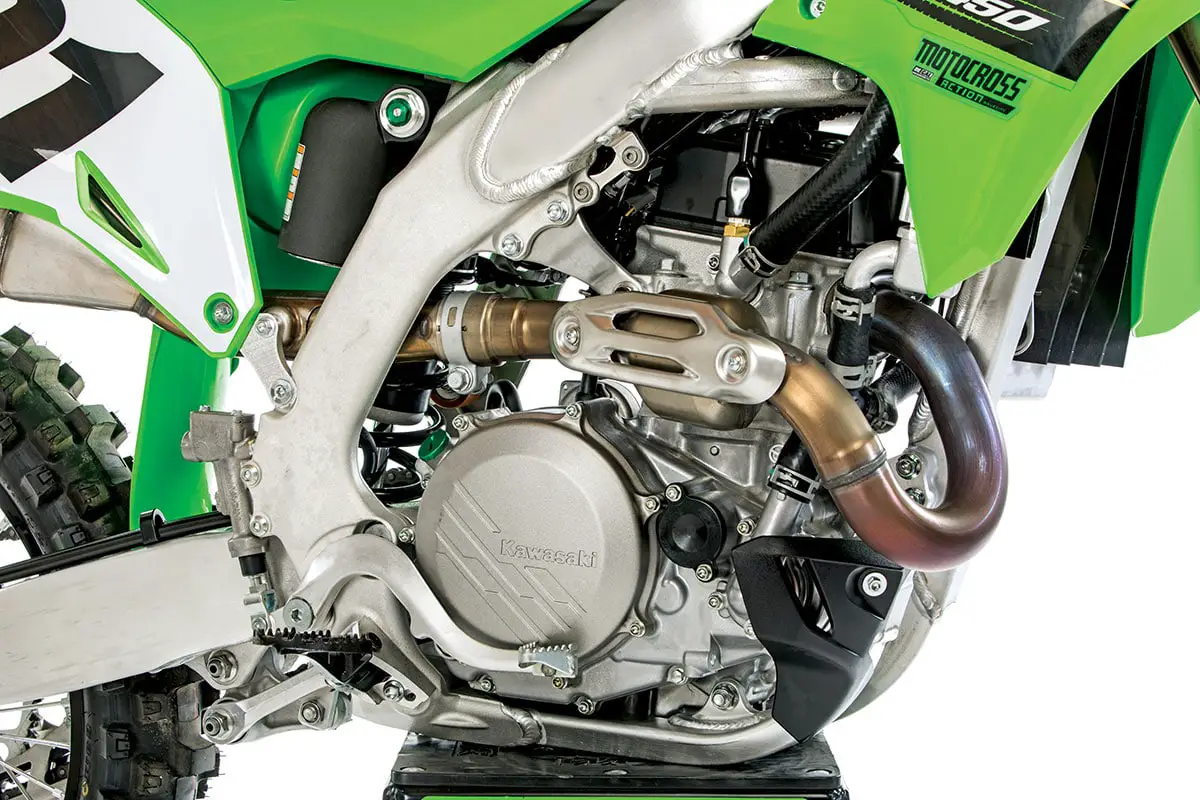
Q: IS THERE A WAY TO IMPROVE THE 2019–2020 KX450 CLUTCH?
A: Yes, there are three ways. Kawasaki is the first of the “Big Four” Japanese makers to offer a hydraulic clutch. And while we like that Kawasaki stepped up to the plate, we still burned through 2019–2020 KX450 clutch plates at the same rate as in the past. Why? Three reasons.
One: The MXA test riders hate judder springs because a judder spring clutch has less surface area on the gripping surface of the clutch plates and a strange connection from the hand to the lever. On the 2020 KX450, the MXA test riders remove the miniaturized judder spring fiber plate, ring-like Belleville washer and the flat spacer and replace them with one additional full-size clutch plate. This makes the KX450 clutch last longer and work better.
Two: Kawasaki may have added hydraulic pressure to activate the push-rod, but they did very little to beef up the actual clutch mechanism itself. In stock trim, the clutch springs are too soft. We added stiffer Pro Circuit clutch springs, but we didn’t run all of the aftermarket clutch springs in the kit; instead, we fine-tuned the feel by only running three of the stiffer clutch springs.
Three: On the 2019–2020 KX450, when the clutch lever is pulled against the two fingers that are left on the handlebars, the clutch is not completely disengaged. In short, when pulled in, the KX450 clutch might actually be slipping it. Our fix was to switch the stock clutch lever for an ARC six-way adjustable Power lever. Why? Because the Power lever allows the rider to choose different ratios between the lever’s pivot center and the point of contact with the master cylinder’s piston. This changes how far the internal push-rod moves per millimeter of lever travel. With the ARC Power lever, the KX450 clutch was disengaged completely, even if the lever hit our fingers.

Q: WHAT’S UP WITH THE 2020 KX450 AIRBOX DESIGN?
A: At first glance, the side-mounted KX450 airbox and air filter look like a cool idea—until you start living with them. Problems? We have a few: (1) It takes two different-size sockets to get the airbox cover off. (2) When you remove the top airbox cover bolt, which doubles as the left seat bolt, the nut plate that it threads into falls out of its recess in the rear fender and lands on the ground. (3) Kawasaki’s filter cage design is difficult to use, which is odd because Kawasaki redesigned it to make it easier to use. (4) The airbox is so small that there is no room to maneuver the cage, and you can’t see the hook and post when you are installing the filter.
Q: HAS KAWASAKI FIXED ITS CHAIN ROLLER ISSUES ON THE 2020 KX450?
A: No. The lower chain roller, the one under the frame that keeps the chain from whipping as it spins off the countershaft sprocket, self destructs in an amazingly short amount of time. When you add the chain roller to Kawasaki’s longterm problems with its rear chain guide, you realize it is best to keep TM Designworks on your speed-dial.
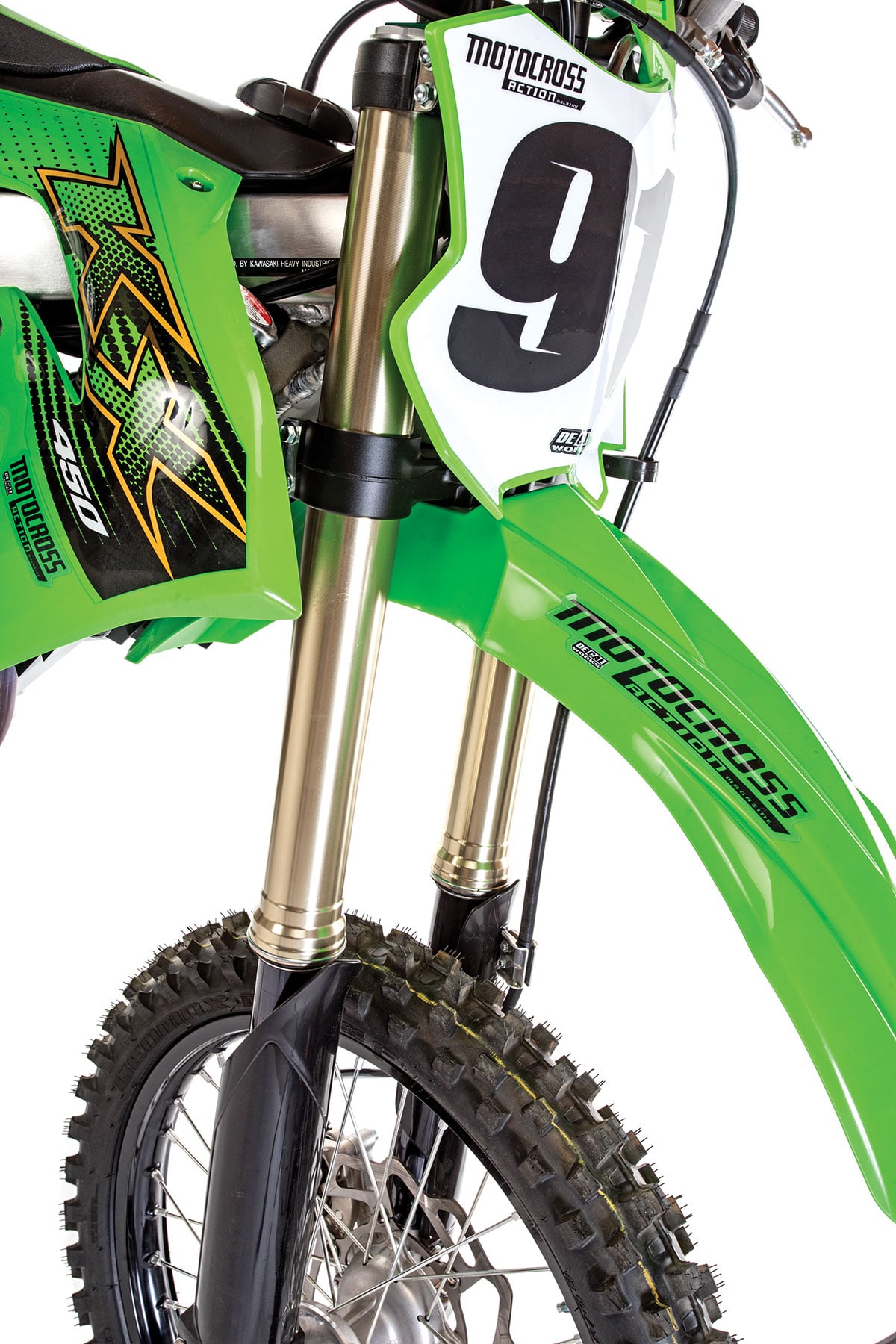
Q: WHAT DOES THE 2020 KX450 WEIGH?
A: Kawasaki is the only Japanese motocross manufacturer to take weight seriously. The bike hits the scales at 233 pounds. That is 5 pounds less than its closest Big Four rival; however, it is 10 pounds heavier than the lightest bike in the class—the 223-pound KTM 450SXF.
Q: WHY IS THE REAR BRAKE SO GRABBY?
A: The 2019–2020 KX450 rear brake is very touchy. Why? The rear brake-pedal adjustment is too limited, and the jumbo-sized 250mm rear rotor is too aggressive. Every MXA test rider had issues with locking up on the entrance to turns. To lessen the grabbiness, we chamfered the edges of the rear brake pads at an angle to allow the pads to slide onto the rotor more efficiently and to downsize the pad’s surface area. We also hacksawed three threads off the bottom of the threaded master cylinder rod to give the pedal more downward free-play so that a boot can touch it without locking up the brakes by accident.

Q: HOW TO STOP IT FROM OVERHEATING?
A: When pushed hard on a hot day or in deep sand or over a long moto, the KX450 overheats. Our simple solution was to increase the pressure in the radiator cap. We installed a 2.0 kg/cm2 Twin Air Ice Flow radiator cap, which raised the boiling point of the water to approximately 250 degrees Fahrenheit.
Q: WHAT’S THE BIGGEST PROBLEM WITH THE KX450 FORKS?
A: The 49mm Showa coil-spring forks are a massive improvement over the Showa SFF-TAC air fork from 2018. The 2020 Showa coil-spring forks are touted as being A-Kit copies. We’ll accept that, because there are only so many things you can do to coil-spring forks to make them better. Eventually, the stuff they were using on A-Kit forks a decade ago would filter down to the production forks. That is how development works.
Every MXA test rider loved the feel of the 2020 KX450 Showa forks. They were plush, comfortable and, best of all, followed the ground better than the TAC air forks. The slower the test rider, the more he liked the 2020 KX450 forks. Conversely, the faster the test rider, the less he liked the 2020 KX450 forks. Why the dichotomy? For fast Intermediates and Experts, the KX450 fork is too soft to hit anything bigger than a cherry bonbon without bottoming.
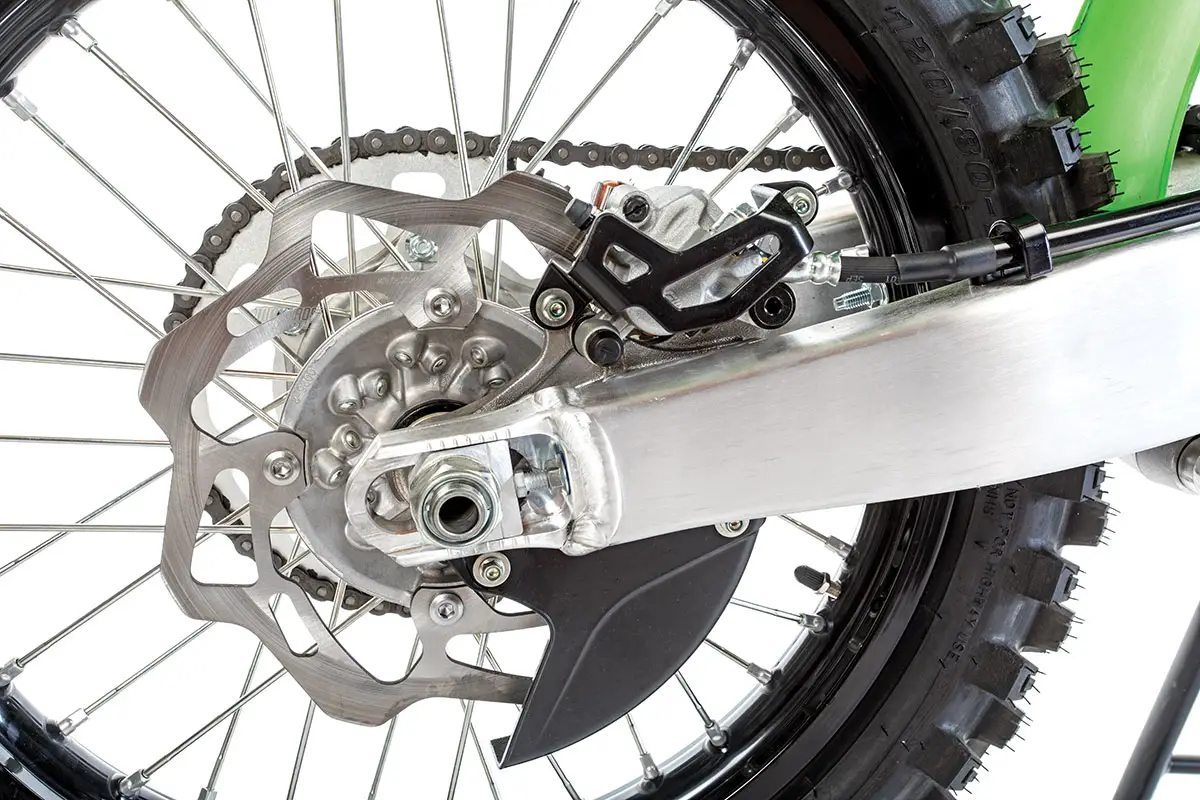
Q: WHAT’S THE SIMPLEST WAY TO FIX THE KX450F FORKS?
A: There is a simple solution for both fast and slow riders. Kawasaki’s stock spring rate is 5.0 N/mm. Kawasaki offers optional 5.2 N/mm springs. MXA’s faster or heavier test riders opted for the stiffer fork springs. For the Vet test riders, we went the “Baby Bear” route of switching to a 5.1 N/mm spring rate; however, Showa doesn’t offer a 5.1 N/mm spring. No sweat! We left the stock 5.0 spring in the right fork leg and put a 5.2 optional spring in the left fork leg. Voila! By math magic, we had a 5.1 N/mm spring. And, for light and slow test riders, we left the stock 5.0 N/mm springs in and added fork oil in both legs in small 5cc increments to lessen bottoming. Short of sending your KX450 forks out for a re-valve, this is the simplest fix.
Q: WHAT DID WE HATE?
A: The hate list:
(1) Rear brake pedal. For our tastes, the rear brake pedal could use more downward adjustment range. It is easy to run the brake pedal high but almost impossible to run it low. Plus, the 250mm rear rotor is very touchy and easy to lock up.
(2) Airbox. So close to good and yet so far.
(3) Clutch. It’s hydraulic, which is a nice touch, but it’s not as good as the hydraulic clutches on the European brands.
(4) Handlebars. Many of the old-school MXA test riders prefer 7/8-inch handlebars over 1-1/8-inch oversize bars. Kawasaki has been holding out on going big, but with the clutch perch, kill button, launch control button, electric starter button, brake perch, throttle assembly and crossbar clamps, there is very little room left on 7/8-inch bars.
(5) Levers. For some unknown reason, the clutch and brake levers are completely different‚ as though they came off different bikes. Most test riders liked the wider profile of the clutch lever and disliked the narrower and shorter profile of the front brake lever.
(6) Fork guards. Kawasaki might as well make its fork guards out of glass. They not only crack when hit by roost, but the rocks actually blow shotgun-style holes in the fork guards. Order aftermarket fork guards while you are ordering the aftermarket chain roller, Pro Circuit clutch springs, ARC levers, Twin Air radiator cap and stiffer fork springs.
(7) Shock preload ring. MXA has complained about KTM’s nylon preload ring for a decade. Guess what? Suzuki and Kawasaki copied it. We use a long screwdriver to pry on the preload ring while using the frame as the fulcrum.
(8) First year model. In 2019, the KX450 was a first-year model. Buying a first-year model is always a gamble because it has no track record. We are surprised that the Kawasaki engineers didn’t fix the obvious flaws for the second model year.
Q: WHAT DID WE LIKE?
A: The like list:
(1) Power. This is an incredibly lively powerband. It snaps to attention with the tiniest twist of the wrist.
(2) Finger-followers. The KTM was the first motocross bike to come with finger-followers (small levers that activate the valves instead of rocker arms or buckets) over 10 years ago. Honda followed suit in 2017, and the Kawasaki KX450 joined the party in 2019.
(3) Plain bearings. Kawasaki switched to plain bearings, essentially bushings coated with an anti-friction material. They offer more surface area per contact patch, longer fatigue life, no brinneling, and no moving parts—perfect for connecting-rod use.
(4) Handling. Once you stop the forks from blowing through the mid-stroke, the KX450 is a sweet-turning machine. Actually, when the forks blow through the mid-stroke, it turns even sharper‚ just not as sweet.
(5) Electric starting. KTM has been using electric start on its race bikes since 2007. The 2019 KX450 was Kawasaki’s first-ever electric-start motocross bike.
(6) Footpegs. The KX450 footpegs can be moved down 5mm if you so desire. On the new chassis, the lower position felt better.
(7) Weight. The 2020 Kawasaki KX450 is the lightest Japanese-made motocross bike on the showroom floors. It’s easy to look good next to the 238-pound CRF, 238-pound YZ-F and 241-pound RM-Z, but not so sweet when you compare it to the 223-pound KTM 450SXF.
Q: WHAT DO WE REALLY THINK?
A: Test riders with a wide range of skills, weight and speed raced this bike every week, in every class. We lived with it—not for a day or two, but for months. In the end, the MXA wrecking crew loved the 2020 Kawasaki KX450. But, just like a beautiful model who irritatingly chews gum 18 hours a day, there were things that got on our nerves about the KX450. Kawasaki didn’t fix the KX450’s bad habits, but MXA found ways to make the KX450 handle better, last longer and be stronger.
MXA’S 2020 KAWASAKI KX450 SETUP SPECS
This is how we set up our 2020 Kawasaki KX450 for racing. We offer it as a guide to help you find your own sweet spot.
SHOWA COIL SPRING FORK SETTINGS
Here is all you need to know about living happily every after with the 49mm 2020 Kawasaki KX450’s Showa coil-spring forks. We have included spring rates for Vets, Intermediates and Pros. They are massively different, and we don’t think that everyone can live happily ever after with the stock spring rate. It should be noted that we made our 5.1 N/mm spring rate by running a 5.2 N/mm spring in one leg and a 5.0 N/m spring in the other leg. Don’t let your pride get in the way—run these nummbers according to your true skill level. These are the numbers we ran on the 2020 Kawasaki KX450 for hardcore racing:
Spring rate: 5.1 N/mm (5.0 N/mm for light riders, 5.1 N/mm for Vet riders, 5.2 N/mm for fast riders)
Compression: 14 clicks out
Rebound: 12 clicks out
Fork-leg height: 2mm up (0mm)
Notes: If you have to race with the stock fork spring while waiting to get your forks fixed, slide the forks down in the clamps until the top of the triple clamp is even with the bottom of the fork cap. Otherwise, run the forks 2mm up in the clamps.
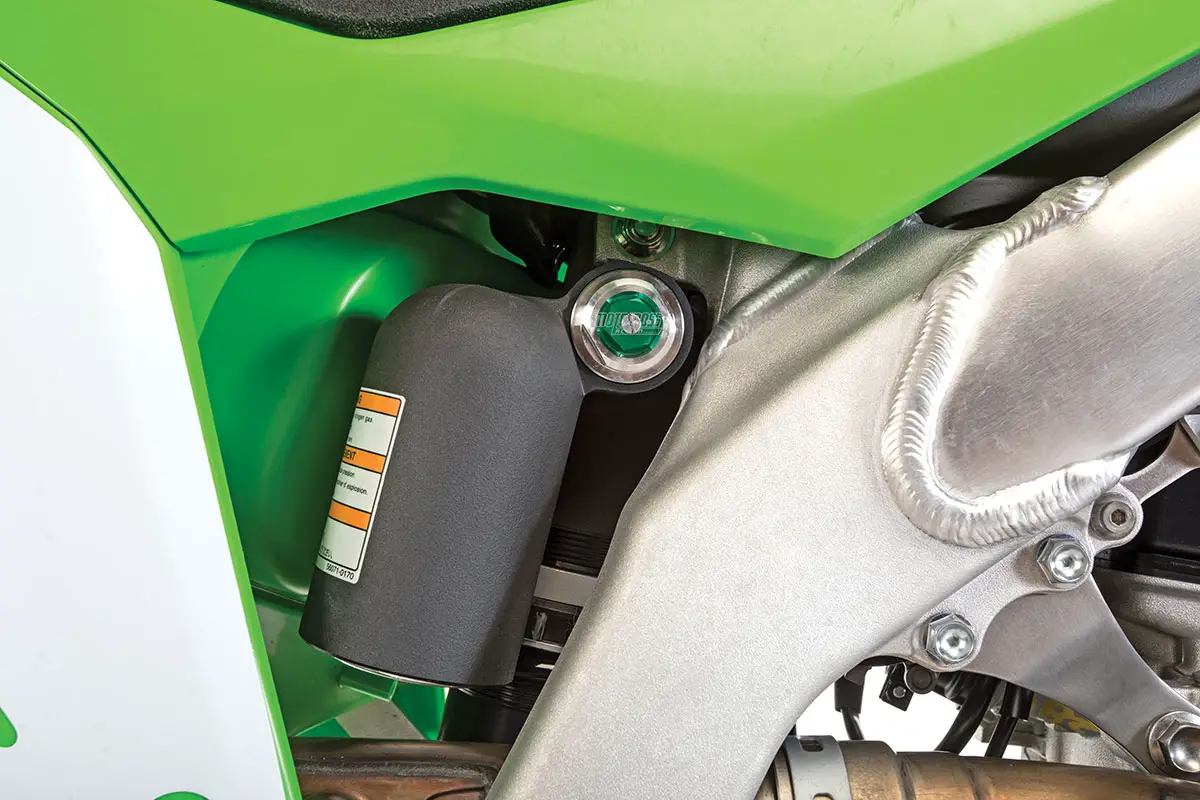
SHOWA SHOCK SETTINGS
The shock worked well from day one, helped by the new linkage and 105mm of sag. We recommend this shock setup on the 2020 Kawasaki KX450 (stock specs are in parentheses):
Spring rate: 54 N/mm
Hi-compression: 1-1/4 turns out
Lo-compression: 18 clicks out
Rebound: 12 clicks out
Race sag: 105mm
Notes: The shock was easy as pie to set up. The rear end had minimal wallowing and worked very well under braking in chop and square-edged bumps. Light riders under 150 pounds might want to switch to the optional 52 N/m shock spring.
WHOA! WE’RE NOT DONE YET: TO READ MORE DETAILED
MXA TESTS OF EACH 2020 450 CLICK BELOW
2020 KAWASAKI KX450 RACE TEST
2020 HONDA CRF450 RACE TEST
2020 KTM 450SXF RACE TEST
2020 HUSQVARNA FC450 RACE TEST
2020 YAMAHA YZ450F RACE TEST
2020 SUZUKI RM-Z450 RACE TEST
2020 MXA 450 SHOOTOUT VIDEO


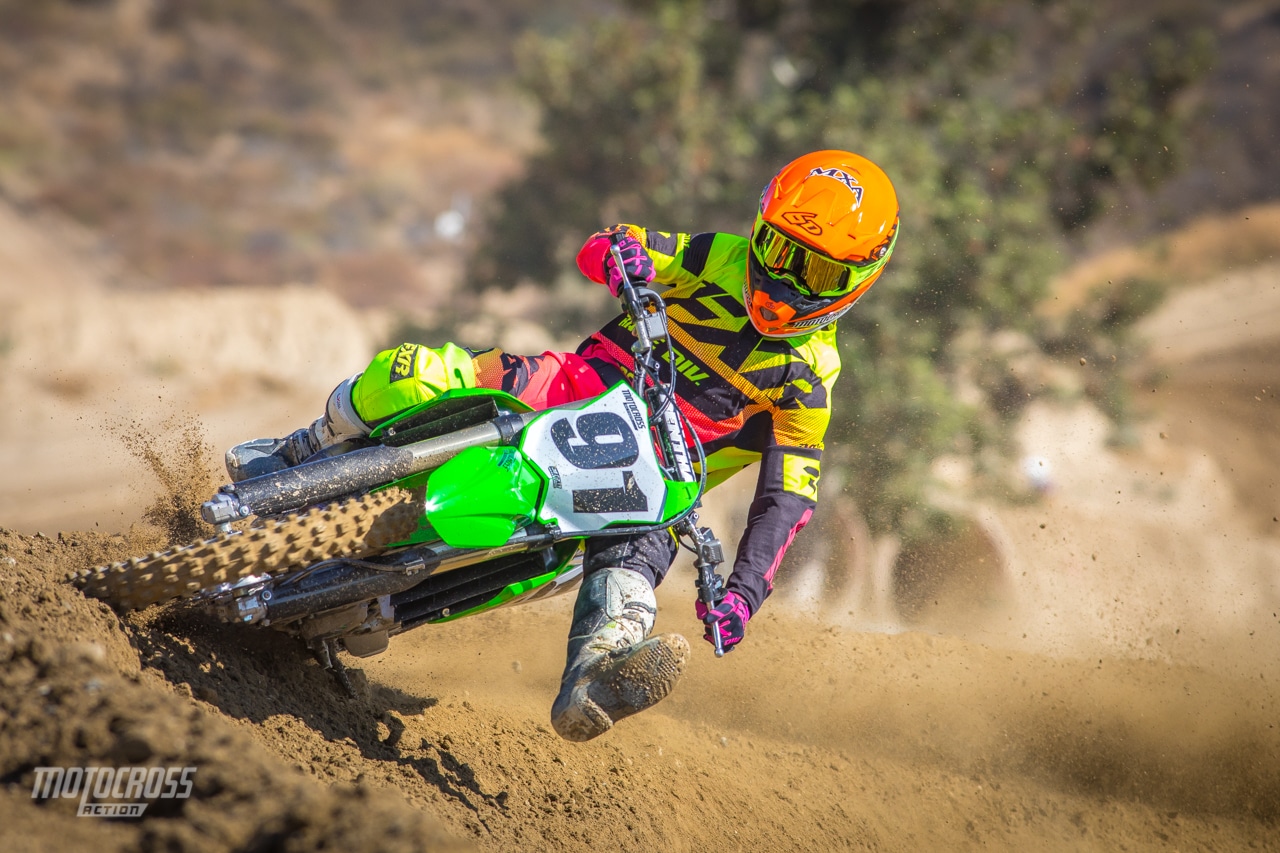
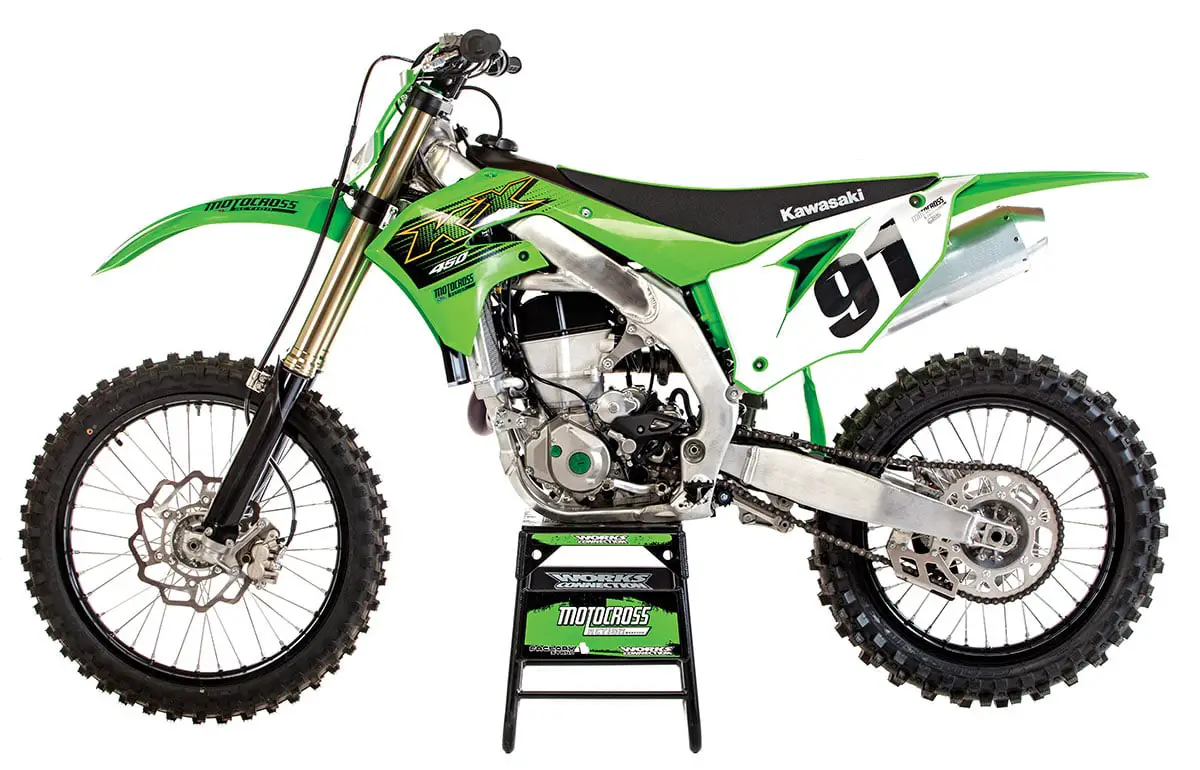
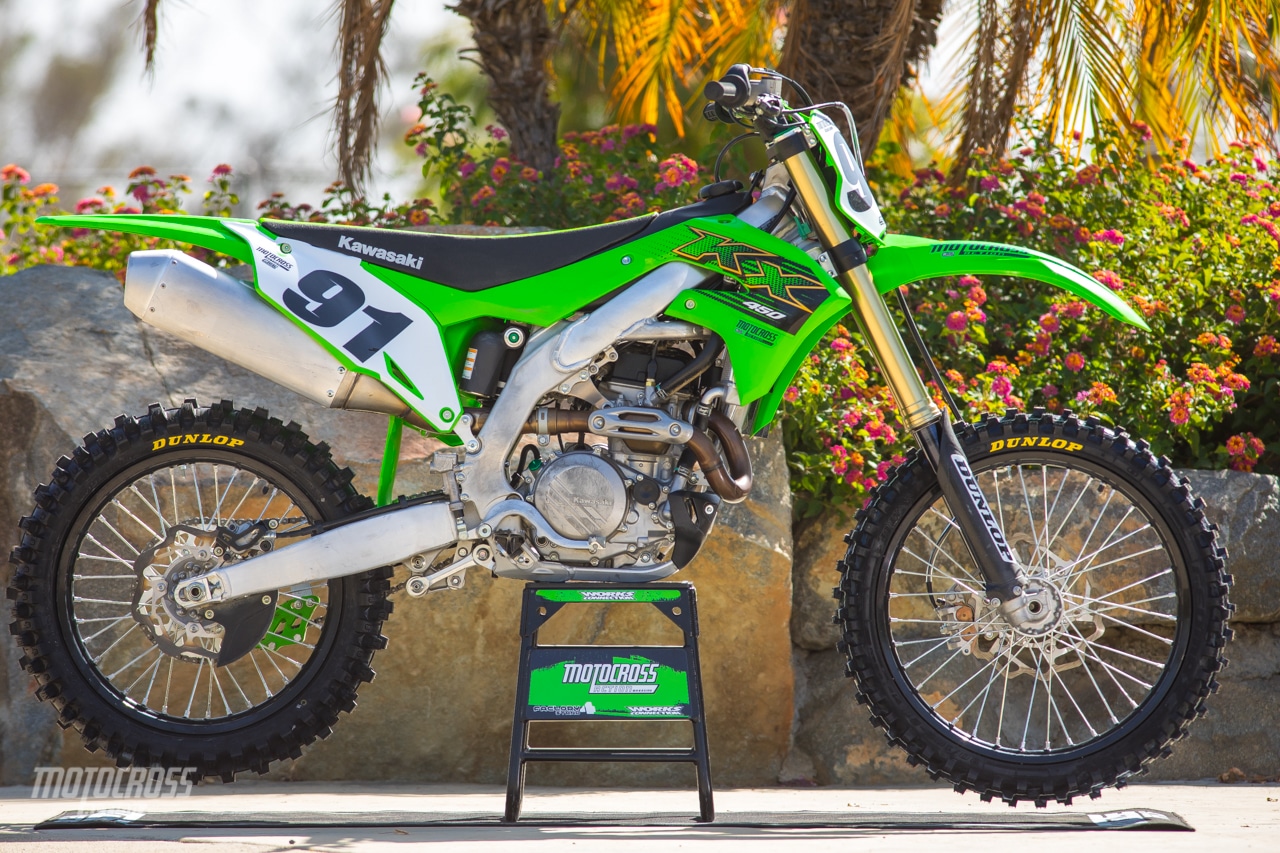
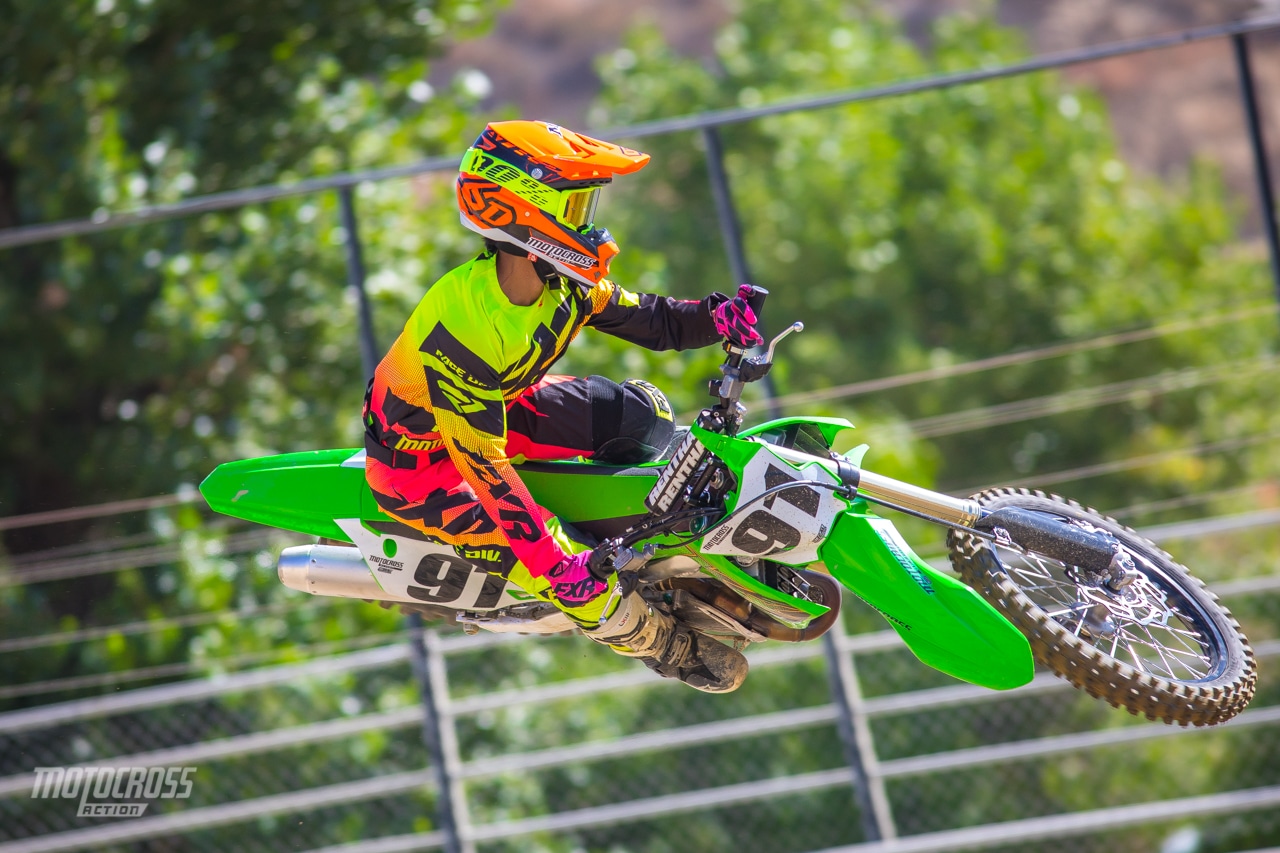
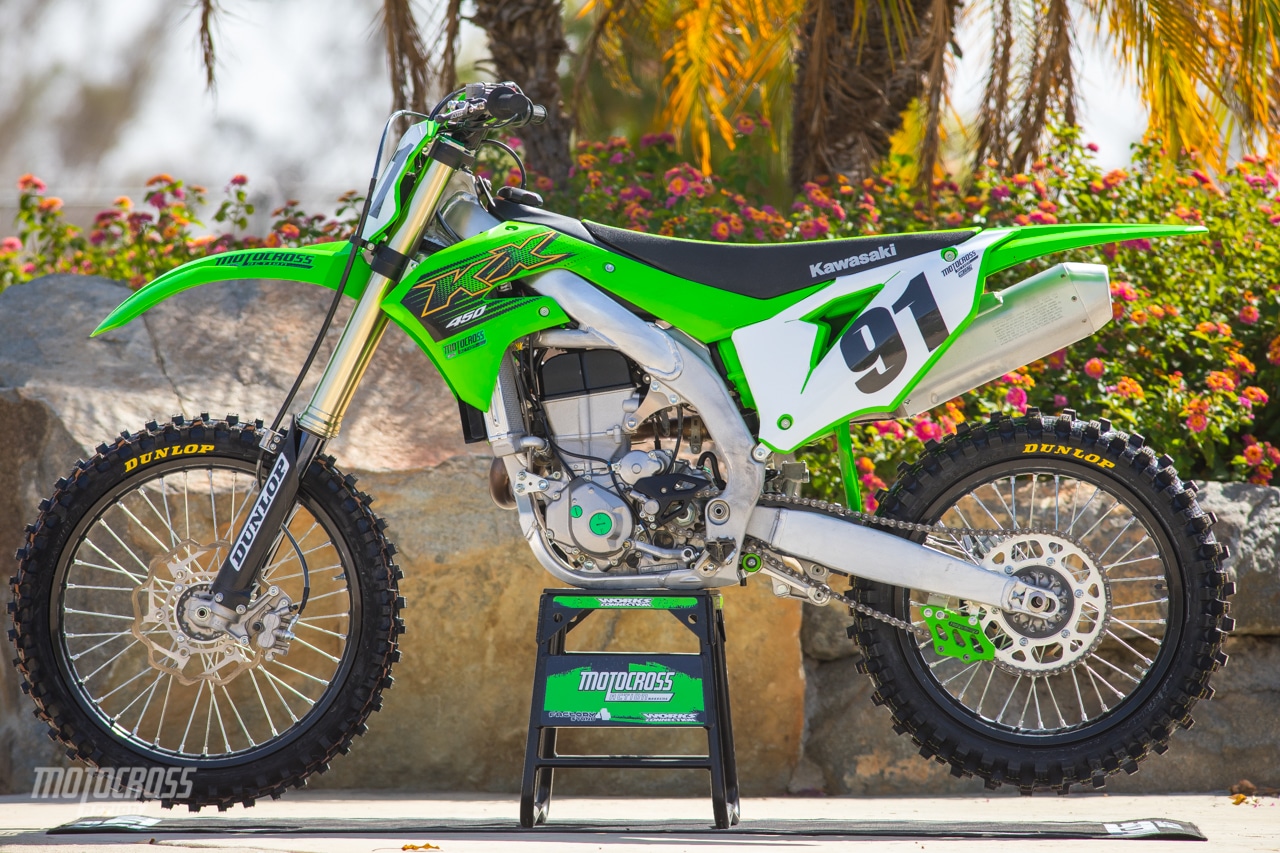


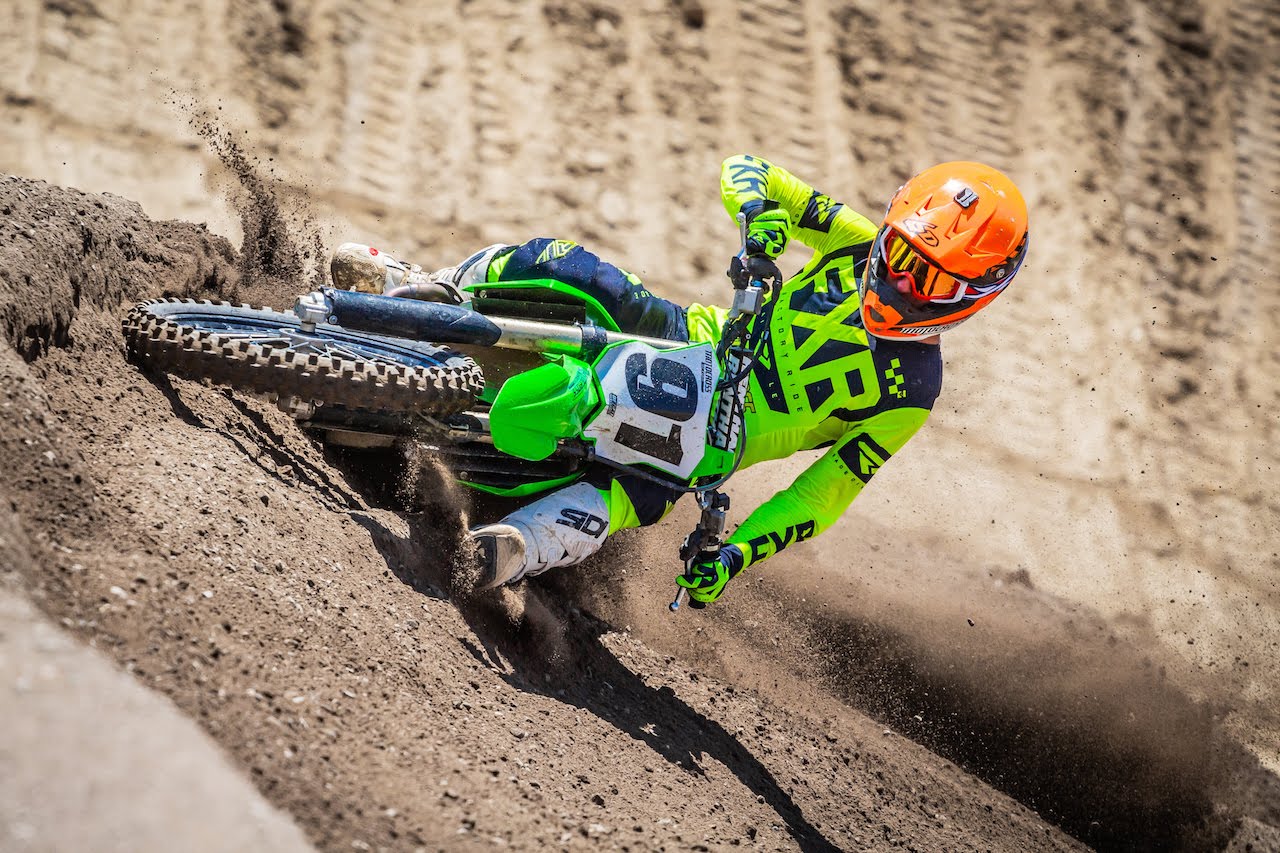
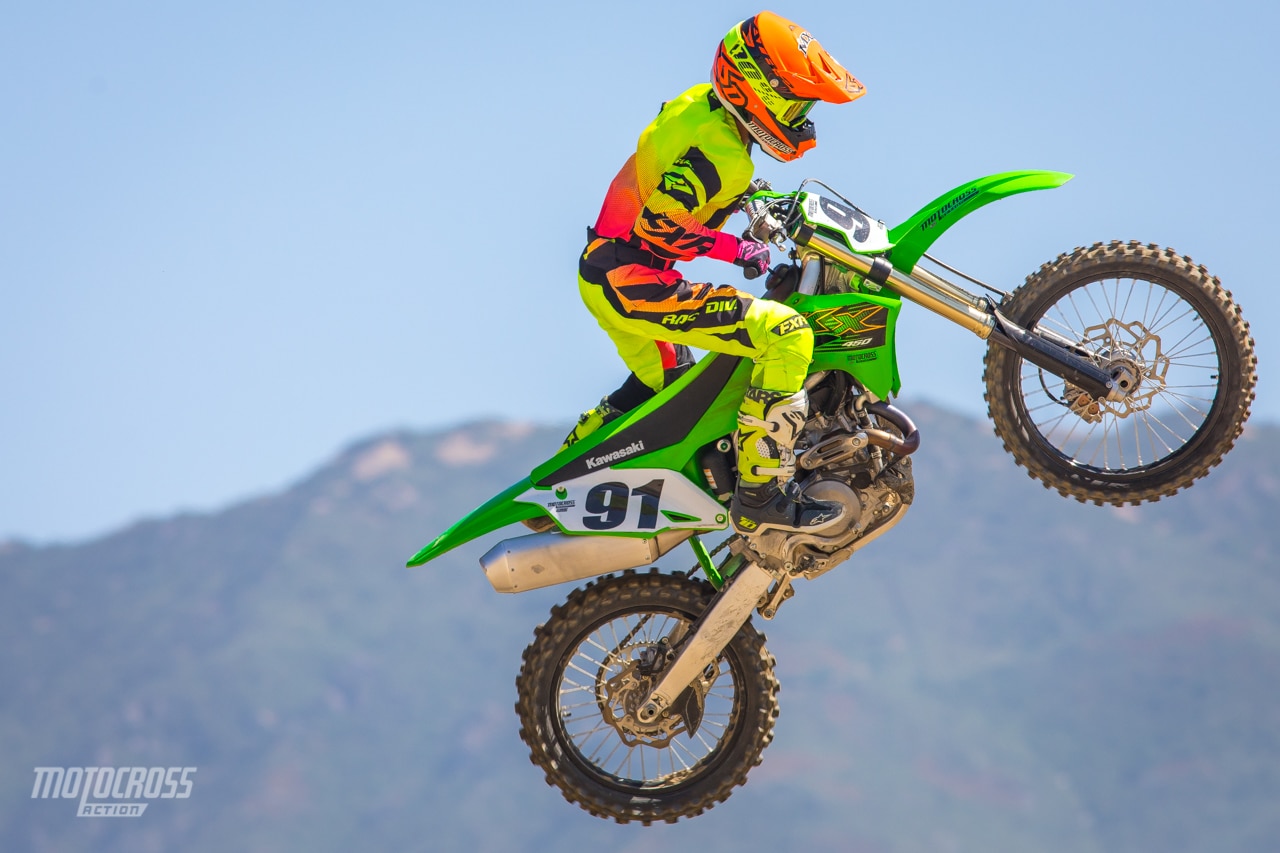




Comments are closed.